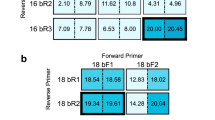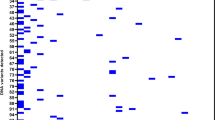Abstract
Cervical scrapes from 116 British women referred with cervical cancer were tested for the presence of high oncogenic risk human papillomavirus (HPV) genotypes (HPVhr). Ninety-four per cent of the scrapes had one or more of these virus types and 66% were HPV16-positive. HPV18 was more frequent in adenocarcinoma. No evidence was found for an increased cancer risk associated with the HPV16 E6 350G variant. The HLA DRB1* and DQB1* alleles in these women and in 155 women with normal cytology and negative for HPVhrDNA were compared. DQB1*0301 alone (2P = 0.02) and in combination with DRB1*0401 (2P = 0.02) was found to be associated with cervical cancer. This was more marked in cancers positive for HPV types other than HPV16. In contrast, DRB1*1501 alone and in combination with DQB1*0602 was not significantly elevated in cancers overall, but did show some excess in HPV16-positive cancers (2P = 0.05), associated with HPV16-positive cervical cancers. Taking all cancers together, a marginally significant protective effect was found for DQB1*0501 (2P = 0.03) but no protective effect could be seen for DRB1*1301. © 2000 Cancer Research Campaign
Similar content being viewed by others
Article PDF
Change history
16 November 2011
This paper was modified 12 months after initial publication to switch to Creative Commons licence terms, as noted at publication
References
Apple RJ, Erlich HA, Klitz W, Manos MM, Becker TM and Wheeler CM (1994) HLA DR-DQ associations with cervical carcinoma show papillomavirus-type specificity. Nat Genet 6: 157–162
Bontkes HJ, Van Duin M, De Gruij TD, Duggan-Keen MF, Walboomers JMM, Stukart MJ, Verheijen RHM, Helmerhorst TJM, Meijer CJLM, Scheper RJ, Stevens FRA, Dyer PA, Sinnott P and Stern PL (1998) HPV16 infection and progression of cervical intra-epithelial neoplasia: analysis of HLA polymorphism and HPV16 E6 sequence variants. Int J Cancer 78: 166–171
Bosch FX, Manos MM, Munoz N, Sherman M, Jansen AM, Peto J, Schiffman MH, Moreno V, Kurman R and Shah KV (1995) Prevalence of human papillomavirus in cervical cancer: a worldwide perspective. J Natl Cancer Inst 87: 78–84
Cuzick J, Beverley E, Ho L, Terry G, Sapper K, Mielzynska I, Lorincz A, Chan W-K, Krausz P and Soutter P (1999) HPV testing in primary screening of older women. Br J Cancer 81: 554–558
Duggan-Keen MF, Keating PJ, Stevens FRA, Sinnott P, Snijders PLF, Walboomers JMM, Davidson S, Hunter RD, Dyer PA and Stern PL (1996) Immunogenetic factors in HPV-associated cervical cancer: influence on disease progression. Eur J Immunogen 23: 275–284
Hildesheim A, Schiffman MH, Gravitt PE, Glass AG, Greer CE, Zhang T, Scott DR, Rush BB, Lawler P, Sherman ME, Kurman RJ and Manos MM (1994) Persistence of type-specific human papillomavirus infection among cytologically normal women. J Infect Dis 169: 235–240
Hildesheim A, Schiffman M, Scott DR, Marti D, Kissner T, Sherman ME, Glass AG, Manos MM, Lorincz AT, Kurman RJ, Buckland J, Rush BB and Carrington M (1998) Human leukocyte antigen class I/II alleles and development of human papillomavirus-related cervical neoplasia: Results from a case-control study conducted in the United States. Can Epidemiol Biomarkers Prev 7: 1035–1041
IARC (1995) Human papillomavirus IARC monographs on the evaluation of carcinogenic risks to humans, Vol. 64. IARC: Lyon
Londesborough P, Ho L, Terry G, Cuzick J, Wheeler C and Singer A (1996) Human papillomavirus genotype as a predictor of persistence and development of high-grade lesions in women with minor cervical abnormalities. Int J Cancer 69: 364–368
Lorincz AT, Reid R, Jenson AB, Greenberg MD, Lancaster W and Kurman RJ (1992) Human papillomavirus infection of the cervix: relative risk associations of 15 common anogenital types. Obs Gynaecol 79: 328–337
Nindl I, Rindfleisch K, Lotz B, Schneider A and Durst, (1999) Uniform distribution of HPV16 E6 and E7 variants in patients with normal histology, cervical intra-epithelial neoplasia and cervical cancer. Int J Cancer 82: 203–207
Odunsi K, Terry G, Ho L, Bell J, Cuzick J and Ganesan TS (1996) Susceptibility to human papillomavirus-associated cervical intra-epithelial neoplasia is determined by specific HLA DR-DQ alleles. Int J Cancer 67: 595–602
Sanjeevi CB, Hjelmstrom P, Hallmans G, Wiklund F, Lenner P, Angstrom T, Dillner J and Lernmark A (1996) Different HLA-DR-DQ haplotypes are associated with cervical intraepithelial neoplasia among human papillomavirus type-16 seropositive and seronegative Swedish women. Int J Cancer 68: 409–414
Terry G, Ho L and Cuzick J (1998) Analysis of E2 amino acid variants of human papillomavirus types 16 and 18 and their associations with lesion grade and HLA DR/DQ type. Int J Cancer 73: 651–655
Wank R, Schendel DJ and Thomssen C (1992) HLA antigens and cervical cancer. Nature 356: 22–23
Wheeler CM, Yamada T, Hildesheim A and Jenison SA (1997) Human papillomavirus type 16 sequence variants; identification by E6 and L1 lineage-specific hybridization. J Clin Microbiol 35: 11–19
Xi LF, Koustsky LA, Galloway DA, Kuypers J, Hughes JP, Wheeler CM, Holmes KK and Kiviat NB (1997) Genomic variation of human papillomavirus type 16 and risk for high grade cervical intraepithelial neoplasia. J Natl Cancer Inst 89: 796–802
Yamada T, Wheeler CM, Halpern AL, Stewart ACM, Hildesheim A and Jenison SA (1995) Human papillomavirus type 16 variant lineages in United States populations characterised by nucleotide sequence analysis of the E6, L2 and L1 coding segments. J Virol 69: 7743–7753
Zehbe I, Voglino G, Delius H, Wilander E and Tommasino M (1998a) Risk of cervical cancer and geographical variations of human papillomavirus 16 E6 polymorphisms. Lancet 352: 1441–1442
Zehbe I, Wilander E, Delius H and Tommasino M (1998b) Human papillomavirus 16 E6 variants are more prevalent in invasive cervical carcinoma than the prototype. Cancer Res 58: 829–833
Author information
Authors and Affiliations
Rights and permissions
From twelve months after its original publication, this work is licensed under the Creative Commons Attribution-NonCommercial-Share Alike 3.0 Unported License. To view a copy of this license, visit http://creativecommons.org/licenses/by-nc-sa/3.0/
About this article
Cite this article
Cuzick, J., Terry, G., Ho, L. et al. Association between high-risk HPV types, HLA DRB1* and DQB1* alleles and cervical cancer in British women. Br J Cancer 82, 1348–1352 (2000). https://doi.org/10.1054/bjoc.1999.1103
Received:
Revised:
Accepted:
Published:
Issue date:
DOI: https://doi.org/10.1054/bjoc.1999.1103
Keywords
This article is cited by
-
Genome, HLA and polygenic risk score analyses for prevalent and persistent cervical human papillomavirus (HPV) infections
European Journal of Human Genetics (2024)
-
Physiopathology and effectiveness of therapeutic vaccines against human papillomavirus
Environmental Science and Pollution Research (2021)
-
Frequency distribution of HLA alleles and haplotypes in Uyghur women with advanced squamous cell cervical cancer and relation to HPV status and clinical outcome
Archives of Gynecology and Obstetrics (2018)
-
A functional polymorphism in the NKG2D gene modulates NK-cell cytotoxicity and is associated with susceptibility to Human Papilloma Virus-related cancers
Scientific Reports (2016)
-
The frequency of HLA alleles in the Romanian population
Immunogenetics (2016)



